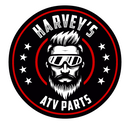How Does a Polaris Primary Clutch Work?

How Does a Polaris Primary Clutch Work?
You know the feeling of a good clutch engaging. You twist the handle or drop the pedal and your ride revs and blasts forward. Suddenly you're ripping through the woods, no shifting required. If you're like Harvey, you dig the speed and power that comes with a Polaris ATV, but hold as much appreciation for the screaming metal precision that makes the ride work.
The Polaris primary clutch is one of the most crucial and intricate parts of your ATV, but the mechanics behind it are basic physics — leverage, resistance, mass, and centrifugal force.
In this article, we’ll explain the different parts and functions of an ATV primary clutch.
The Polaris Primary Clutch - Introducing the CVT
In a standard clutch, the vehicle will start in one gear and then shift to a second gear when the rate of acceleration outpaces rotations per minute (RPMs).
The Continuously Variable Transmission (CVT) can be best explained as a gear changer without gears. It may seem like a new design compared to manual gear shifts, but its core concept can be traced back to sketches from Leonardo Da Vinci.
In 1879, Milton Reeves built the first true variable-speed transmission to use in a sawmill engine, later adapting it for use in cars. His design went on to inspire friction belt CVTs, which have evolved into the systems our ATVs run on today.
Unlike a manual or automatic transmission, there are no gears to shift and no tangled hydraulic systems. There are three major components of a Polaris CVT: theprimary clutch, the belt, and the secondary clutch.
How does a CVT clutch work?
As RPMs increase, the sheaves on the primary clutch close in on the belt and engage it through friction, starting the drivetrain. The belt rides up the tapered faces of the sheaves, moving outward and effectively creating a larger “gear.” The secondary clutch responds in mirrored image, picking up the belt’s slack as the plates shift.
Polaris Primary Clutch Springs

Polaris Primary Clutch Weights

Centrifugal Force?
Polaris Clutch Balancing
Subscribe
To join our mailing list and never miss the latest ATV tips, tricks, and discounts!

